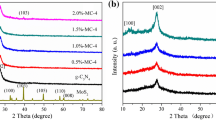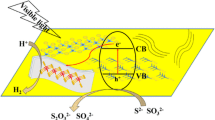Abstract
The conversion of CO2 into CO, CH4 and other hydrocarbons through solar energy can alleviate the energy shortage problem. We design a novel photocatalyst with S defects CuIn5S8@MoSe2 hollow structure. The interlayer-expanded MoSe2 can increase the adsorption of intermediates. The unique hollow structure can improve the light utilization efficiency and the electron–holes separation. CuIn5S8 with S vacancies in bimetallic sites has high selectivity and photocatalytic reduction of CO2 activity. Therefore, S vacant CuIn5S8 confined in a few-layers MoSe2 with interlayer-expanded hollow heterostructures exhibit super performance for photocatalytic CO2 reduction. After 8-h light reaction, the outputs of CO and CH4 for the 15.3 wt% CuIn5S8@MoSe2 sample containing S vacancies (Vs) are 30.4 and 14.7 µmol·g−1, respectively. The mechanism is also investigated in detail through in situ Fourier transform infrared spectroscopy technology.
Graphic abstract

摘要
有效利用太阳能将CO2转化为CO, CH4和其他碳氢化合物, 可缓解能源及环境问题. 本研究设计了一种新颖的富含S缺陷的中空结构CuIn5S8@MoSe2可见光光催化剂。 层面间距扩展的MoSe2可以增加中间产物的吸附. 独特的中空结构可以提高光利用效率和电子-空穴的分离效率, 双金属位点, 硫空位的CuIn5S8具有高光催化还原CO2活性。 因此, 富含硫空位的CuIn5S8@MoSe2表现出优异的光催化CO2还原性能. 经过8小时的光反应, CuIn5S8(15.3 wt%)@MoSe2样品光催化还原产物CO和CH4的产量分别为30.4和14.7 µmol·g-1. 并且, 通过原位红外光谱技术详细研究了CO2光催化还原机制。








Similar content being viewed by others
References
Xu ZX, Wang AQ, Zhu YF. Controllable synthesis and tunable photocatalytic activity of TiO2 nanowires via alcohol-thermal method. Rare Met. 2019;38(5):390.
Yang Y, Zhang Y, Hu JS, Wan LJ. Progress in the mechanisms and materials for CO2 electroreduction toward C2+ products. Acta Phys -Chim Sin. 2020;6(1):906085.
Wang HP, Guan ZC, Wang X, Jin P, Xu H, Chen LF, Song GL, Du RG. Fabrication of a ZnSe/MoO3/TiO2 composite film exhibiting photocathodic protection effect. Acta Phys -Chim Sin. 2019;5(11):1232.
Fei HF, Liu YP, Wei CL, Zhang YC, Feng JK, Chen CZ, Yu HZ. Poly(propylene carbonate)-based polymer electrolyte with an organic cathode for stable all-solid-state sodium batteries. Acta Phys Chim Sin. 2020;6(5):905015.
Wang Y, Zhao JX, Chen Z, Zhang F, Guo W, Lin HM, Qu FY. Construction of Z-scheme MoSe2/CdSe hollow nanostructure with enhanced full spectrum photocatalytic activity. Appl Catal B. 2019;44:76.
Yi JJ, Li HP, Gong YJ, She XJ, Song YH, Xu YG, Deng JJ, Yuan SQ, Xu H, Li HM. Phase and interlayer effect of transition metal dichalcogenide cocatalyst toward photocatalytic hydrogen evolution: the case of MoSe2. Appl Catal B. 2019;43:330.
Lu ZQ, Zeng DQ, Zheng HF, Liu QQ, Gao XY, He XL, Wei L, Ong WJ. Enhanced interfacial electron transfer and boosted visible-light photocatalytic hydrogen evolution activity of g-C3N4 by noble-metal-free MoSe2 nanoparticles. J Mater Sci. 2020;55:13114.
Ren ZX, Liu XJ, Chu HP, Yu HZ, Xu YY, Wei Q, Lei WY, Chen PB, Li JW, Li C. Carbon quantum dots decorated MoSe2 photocatalyst for Cr(VI) reduction in the UV–vis-NIR photon energy range. J Colloid Interface Sci. 2017;88:190.
Yousaf M, Wang YS, Chen YJ, Wang ZP, Firdous A, Ali Z, Zou RQ, Guo SJ, Han R. A 3D trilayered CNT/MoSe2/C heterostructure with an expanded MoSe2 interlayer spacing for an efficient sodium storage. Adv Energy Mater. 2019;30:1900567.
Zeng LX, Fang YX, Xu LH, Zheng C, Yang MQ, He JF, Xue H, Qian QR, Wei MD, Chen QH. Rational design of few-layer MoSe2 confined within ZnSe-C hollow porous spheres for high-performance lithium-ion and sodium-ion batteries. Nanoscale. 2019;1:6766.
Pomar CD, Souza AT, Sombrio G, Souza FL, Bonvent JJ, Souza JA. Synthesis of SnS and ZnS hollow microarchitectures decorated with nanostructures and their photocatalytic behavior for dye degradation. ChemistrySelect. 2018;13:3774.
Wang W, Zeng ZT, Zeng GM, Zhang C, Xiao R, Zhou CY, Xiong WP, Yang Y, Lei L, Liu Y, Huang DL, Cheng M, Yang YY, Fu YK, Luo HZ, Zhou Y. Sulfur doped carbon quantum dots loaded hollow tubular g-C3N4 as novel photocatalyst for destruction of Escherichia coli and tetracycline degradation under visible light. Chem Eng J. 2019;78:352.
Wang ZY, Chen MJ, Huang Y, Shi XJ, Zhang YF, Huang TT, Cao JJ, Ho WK, Lee SC. Self-assembly synthesis of boron-doped graphitic carbon nitride hollow tubes for enhanced photocatalytic NOx removal under visible light. Appl Catal B. 2018;39:352.
Ma DD, Shi JW, Sun DK, Zou YJ, Cheng LH, He C, Wang HK, Niu CM, Wang LZ. Au decorated hollow ZnO@ZnS heterostructure for enhanced photocatalytic hydrogen evolution: The insight into the roles of hollow channel and Au nanoparticles. Appl Catal B. 2019;44:748.
Kang X, Song XZ, Han Y, Cao J, Tan Z. Defect-engineered TiO2 Hollow spiny nanocubes for phenol degradation under visible light irradiation. Sci Rep. 2018;8(1):5904.
Wang M, Guo PY, Zhang Y, Lv CM, Liu TY, Chai TY, Xie YH, Wang YZ, Zhu T. Synthesis of hollow lantern-like Eu(III)-doped g-C3N4 with enhanced visible light photocatalytic perfomance for organic degradation. J Haz Mater. 2018;349:224.
Zhao SD, Chen JR, Liu YF, Jiang Y, Jiang CJ, Yin ZL, Xiao YG, Cao SS. Silver nanoparticles confined in shell-in-shell hollow TiO2 manifesting efficiently photocatalytic activity and stability. Chem Eng J. 2019;367:249.
Wang SB, Guan BY, Wang X, Lou XWD. Formation of hierarchical Co9S8@ZnIn2S4 heterostructured cages as an efficient photocatalyst for hydrogen evolution. J Am Chem Soc. 2018;140(45):15145.
Yao XX, Hu XL, Zhang WJ, Gong XY, Wang XH, Pillai SC, Dionysiou DD, Wang DW. Mie resonance in hollow nanoshells of ternary TiO2-Au-CdS and enhanced photocatalytic hydrogen evolution. Appl Catal B Environ. 2020;276:119153.
Cui D, Xu K, Dong X, Lv D, Dong F, Hao W, Du Y, Chen J. Controlled hydrogenation into defective interlayer bismuth oxychloride via vacancy engineering. Commun Chem. 2020;3:73.
Zhang SQ, Liu X, Liu CB, Luo SL, Wang LL, Cai T, Zeng YX, Yuan JL, Dong WY, Pei Y, Liu YT. MoS2 quantum dot growth induced by S vacancies in a ZnIn2S4 monolayer: atomic-level heterostructure for photocatalytic hydrogen production. ACS Nano. 2018;12(1):751.
Li H, Li J, Ai ZH, Jia FL, Zhang LZ. Oxygen vacancy-mediated photocatalysis of biocl: reactivity, selectivity, and perspectives. Angew Chem Int Ed. 2018;57(1):122.
Yu HJ, Li JY, Zhang YH, Yang SQ, Han KL, Dong F, Ma TY, Huang HW. Three-in-one oxygen vacancies: whole visible-spectrum absorption, efficient charge separation, and surface site activation for robust CO2 photoreduction. Angew Chem Int Ed. 2019;58(12):3880.
Du C, Zhang Q, Lin ZY, Yan B, Xia C, Yang G. Half-unit-cell ZnIn2S4 monolayer with sulfur vacancies for photocatalytic hydrogen evolution. Appl Catal B. 2019;248:193.
Xu X, Ding X, Yang XL, Wang P, Li S, Lu ZX, Chen H. Oxygen vacancy boosted photocatalytic decomposition of ciprofloxacin over Bi2MoO6: oxygen vacancy engineering, biotoxicity evaluation and mechanism study. J Haz Mater. 2019;364:691.
Li XD, Sun YF, Xu JQ, Shao YJ, Wu J, Xu XL, Pan Y, Ju HX, Zhu JF, Xie Y. Selective visible-light-driven photocatalytic CO2 reduction to CH4 mediated by atomically thin CuIn5S8 layers. Nat Energy. 2019;4(8):690.
Feng CY, Tang L, Deng YC, Wang JJ, Liu YN, Ouyang XL, Chen ZM, Yang HR, Yu JF, Wang JJ. Maintaining stable LSPR performance of W18O49 by protecting its oxygen vacancy: a novel strategy for achieving durable sunlight driven photocatalysis. Appl Catal B Environ. 2020;276:119167.
Lv Z, Zhou H, Liu H, Liu B, Liang M, Guo H. Controlled assemble of oxygen vacant CeO2@Bi2WO6 hollow magnetic microcapsule heterostructures for visible-light photocatalytic activity. Chem Eng J. 2017;330:1297.
Huang SS, Kou X, He D, Du CF, Wang XJ, Su YG. Oxygen-vacancy-mediated photocatalysis over Bi2Sn2O7: exceptional catalytic activity and selectivity. Chem Cat Chem. 2019;11(24):6316.
Xu YC, Li HZ, Sun BJ, Qiao PZ, Ren LP, Tian GH, Jiang BJ, Pan K, Zhou W. Surface oxygen vacancy defect-promoted electron-hole separation for porous defective ZnO hexagonal plates and enhanced solar-driven photocatalytic performance. Chem Eng J. 2020;379:122295.
Cao J, Nie WS, Huang L, Ding YB, Lv KL, Tang HQ. Photocatalytic activation of sulfite by nitrogen vacancy modified graphitic carbon nitride for efficient degradation of carbamazepine. Appl Catal B. 2019;241:18.
Fu F, Shen HD, Sun X, Xue WW, Shoneye A, Ma JN, Luo L, Wang D, Wang JG, Tang JW. Synergistic effect of surface oxygen vacancies and interfacial charge transfer on Fe(III)/Bi2MoO6 for efficient photocatalysis. Appl Catal B. 2019;247:150.
Huang JW, Jin B, Liu HQ, Li XJ, Zhang QC, Chu SJ, Peng RF, Chu S. Controllable synthesis of flower-like MoSe2 3D microspheres for highly efficient visible-light photocatalytic degradation of nitro-aromatic explosives. J Mater Chem A. 2018;6:11424.
Yang XL, Wang SY, Yang N, Zhou W, Wang P, Jiang K, Li S, Song H, Ding X, Chen H, Ye JH. Oxygen vacancies induced special CO2 adsorption modes on Bi2MoO6 for highly selective conversion to CH4. Appl Catal B Environ. 2019;259:118088.
Lee J, Ham S, Choi D, Jang DJ. Facile fabrication of porous ZnS nanostructures with a controlled amount of S vacancies for enhanced photocatalytic performances. Nanoscale. 2018;10:14254.
Mao CL, Wang JX, Zou YJ, Li H, Zhan GM, Li J, Zhao JC, Zhang LZ. Anion (O, N, C, and S) vacancies promoted photocatalytic nitrogen fixation. Green Chem. 2019;21(11):2852.
Xu Q, Zhang L, Cheng B, Fan J, Yu J. S-scheme heterojunction photocatalyst. Chemistry. 2020;6(7):1543.
Xie Q, He W, Liu S, Li C, Zhang J, Wong PK. Bifunctional S-scheme g-C3N4/Bi/BiVO4 hybrid photocatalysts toward artificial carbon cycling. Chin J Catal. 2020;41(1):14053.
Low JX, Dai BZ, Tong T, Jiang CJ, Yu JG. In situ irradiated X-ray photoelectron spectroscopy investigation on a direct Z-scheme TiO2/CdS composite film photocatalyst. Adv Mater. 2019;31(5):1802981.
Wen XJ, Niu CG, Zhang L, Liang C, Zeng GM. A novel Ag2O/CeO2 heterojunction photocatalysts for photocatalytic degradation of enrofloxacin: possible degradation pathways, mineralization activity and an in depth mechanism insight. Appl Catal B. 2018;221:701.
Mano G, Harinee S, Sridhar S, Ashok M, Viswanathan A. Microwave assisted synthesis of ZnO-PbS heterojuction for degradation of organic pollutants under visible light. Sci Rep. 2020;10(1):2224.
Orimolade BO, Arotiba OA. Towards visible light driven photoelectrocatalysis for water treatment: application of a FTO/BiVO4/Ag2S heterojunction anode for the removal of emerging pharmaceutical pollutants. Sci Rep. 2020;10(1):5348.
Liu Y, Kong JJ, Yuan JL, Zhao W, Zhu X, Sun C, Xie JM. Enhanced photocatalytic activity over flower-like sphere Ag/Ag2CO3/BiVO4 plasmonic heterojunction photocatalyst for tetracycline degradation. Chem Eng J. 2018;331:242.
Chen Y, Li S, Zhao RY, Li W, Ren ZH, Han GR. Single-crystal TiO2/SrTiO3 core-shell heterostructured nanowire arrays for enhanced photoelectrochemical performance. Rare Met. 2019;38(5):369.
Li Y, Yang Y, Huang JW, Wang L, She HD, Zhong JB, Wang QZ. Preparation of CuS/BiVO4 thin film and its efficaciously photoelectrochemical performance in hydrogen generation. Rare Met. 2019;38(5):428.
Acknowledgements
This work was financially supported by the National Natural Science Foundation of China (Nos. 52064049, 21467030 and 51764048), the Key National Natural Science Foundation of Yunnan Province (Nos. 2018FA028 and 2019FY003023), the International Joint Research Center for Advanced Energy Materials of Yunnan Province (No. 202003AE140001) and the Key Laboratory of Solid-State Ions for Green Energy of Yunnan University (2019).
Author information
Authors and Affiliations
Corresponding authors
Ethics declarations
Conflicts of interests
The authors declare that they have no conflict of interests.
Supplementary Information
Below is the link to the electronic supplementary material.
Rights and permissions
About this article
Cite this article
Chen, LJ., Liu, TT., Liu, SM. et al. S vacant CuIn5S8 confined in a few-layer MoSe2 with interlayer-expanded hollow heterostructures boost photocatalytic CO2 reduction. Rare Met. 41, 144–154 (2022). https://doi.org/10.1007/s12598-021-01809-x
Received:
Revised:
Accepted:
Published:
Issue Date:
DOI: https://doi.org/10.1007/s12598-021-01809-x




